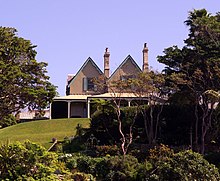Sunnyside, 11 Holbrook Avenue, Kirribilli, NSW
[Previous Post: St Georges Road Mansion, Toorak ...Next Post: ]
- See also Rustic gothic style at Wikipedia

This is not a Federation style house, but the similarities in gabled style are obvious.
- (Victorian) Rustic Gothic style at Wikipedia:
 157 Hotham Street,East Melbourne, Victoria. Completed 1861. |  Greycliffe House, Vaucluse, New South Wales, attributed to John Hilly, circa 1840s. |  Rectory of St Mark's Church, Darling Point, New South Wales. Designed byEdmund Blacket. |  Roslyndale, Woollahra, New South Wales, attributed to Francis Clarke, circa 1856. |
 |
| Kirribilli House |
| Sunnyside, Kirribilli |
- Heritage listed by NSW heritage; "A fine example of its type and period."[1]







